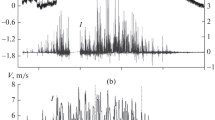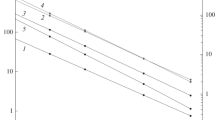Abstract
Using the measurement data in a wind–sand flux on the desertified areas of Astrakhan oblast and Kalmykia, it has been established that the time variability of saltating and dust aerosol particle concentrations, the electric characteristics of the wind–sand flux, including electric currents of saltation, the volume charge of dust aerosol particles, and the electric field intensity in the near-surface layer of the atmosphere within a range of ~30 s to 30 min are determined by the low-frequency variations in the horizontal component of the wind velocity. According to the data of measurements, over the desertified area, the electric charge surface density reaches +25 nC/m2. The empirical probability distribution of a specific charge for sand grains under the condition of quasi-continuous saltation is obtained. A saltation initiation mechanism by electric discharges on the underlayer surface is proposed. An analytical model of particle liftoff to the near-surface layer of the atmosphere by electric discharges on the underlayer surface is presented. It is shown that, during the electric (corona) discharge, the saltating particle launch velocity can exceed 1 m/s.




Similar content being viewed by others
REFERENCES
Y. Shao, Physics and Modeling of Wind Erosion (Springer, New York, 2000).
J. F. Kok, E. I. R. Parteli, T. I. Michaels, and D. Bou Karam, Rep. Prog. Phys. 75, 1–119 (2012).
I. Tegen, A. Lacis, and I. Fung, Nature 380, 419–422 (1996).
N. Mahowald, S. Albani, J. F. Kok, et al., Aeolian Res. 15, 53–71 (2014).
G. I. Gorchakov, V. M. Kopeikin, A. V. Karpov, et al., Atmos. Oceanic Opt. 29 (1), 5–12 (2016).
G. I. Gorchakov, A. V. Karpov, V. M. Kopeikin, et al., Proc. SPIE—Int. Soc. Opt. Eng. 11560, 1156076 (2020).
G. I. Gorchakov, A. V. Karpov, R. A. Gushchin, et al., Dokl. Earth Sci. 496 (2), 119–125 (2021).
K. R. Rasmussen and M. Sorensen, J. Geophys. Res. 113, FO2S12 (2008).
T. D. Ho, P. Dupont, A. O. E. El Moctar, and A. Valanc, Phys. Rev. E 85, 052301 (2012).
Y. Huang, Y. F. Kok, R. Y. Martin, et al., Atmos. Chem. Phys. 19, 2947–2964 (2019).
J. F. Kok and N. O. Renno, Phys. Rev. Lett. 100, 014501 (2008).
D. S. Schmidt, R. A. Schmidt, and Y. D. Dent, J. Geophys. Res. 103 (D8), 8997–9001 (1998).
G. I. Gorchakov, V. I. Ermakov, V. M. Kopeikin, et al., Dokl. Earth Sci. 410 (7), 1109–1112 (2006).
T. G. Bo and X.-Y. Zheng, Aeolian Res. 8, 39–47 (2013).
G. I. Gorchakov, V. M. Kopeikin, A. V. Karpov, et al., Dokl. Earth Sci. 456 (2), 700–705 (2014).
D. V. Sivukhin, General Course of Physics. Electric Energy (Nauka, Fizmatlit, Moscow, 1983) [in Russian].
O. E. Semenov, Introduction to Experimental Meteorology and Sandstorm Climatology (Kazakh Res. Inst. Ecol. Climate, Almaty, 2011) [in Russian].
E. A. Malinovskaya, O. G. Chkhetiani, I. N. Panchishkina, et al., Dokl. Earth Sci. 502 (1–2), 59–68 (2022).
V. V. Smirnov, Ionization in the Troposphere (Gidrometeoizdat, St. Petersburg, 1992) [in Russian].
E. Kamke, Differentialgleichungen, Vol. 1: Gewöhnliche Differentialgleichungen (Akad. Verlagsgesellschaft, 1962).
ACKNOWLEDGMENTS
We are grateful to G.S. Golitsyn for useful advice and O.G. Chkhetiani for discussion of the results.
Funding
This work was supported by the Russian Science Foundation, grant no. 20-17-00214.
Author information
Authors and Affiliations
Corresponding author
Ethics declarations
The authors declare that they have no conflicts of interest.
Additional information
Translated by L. Mukhortova
Rights and permissions
About this article
Cite this article
Gorchakov, G.I., Kopeikin, V.M., Karpov, A.V. et al. Wind–Sand Flux Electrization over Desertified Areas. Dokl. Earth Sc. 505, 483–488 (2022). https://doi.org/10.1134/S1028334X22070078
Received:
Revised:
Accepted:
Published:
Issue Date:
DOI: https://doi.org/10.1134/S1028334X22070078




